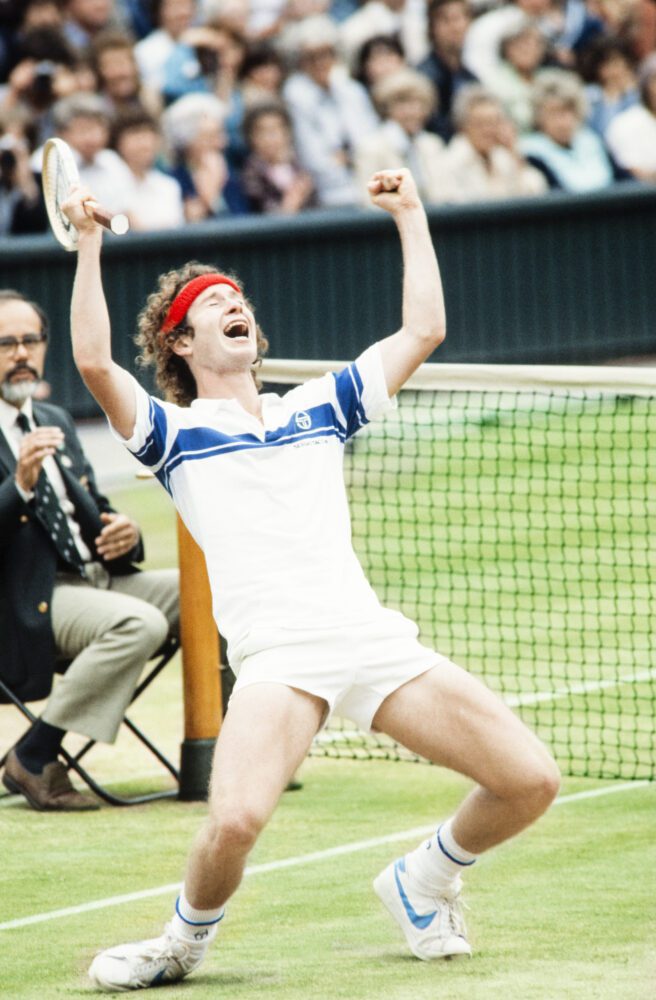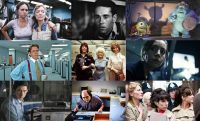Is there, one might reasonably wonder, more to know about John McEnroe? Ever since his surprise run from the qualifiers to the semifinals of Wimbledon in 1977, he’s never really been out of the public eye. There was, of course, at first his sublime tennis, featured in rivalries where he triumphed over the greats of the era: first Jimmy Connors, then Bjorn Borg. And with it, the outbursts, the petulant profanities and pejoratives that led to his “Superbrat” designation. At the height of his fame, he learned to party with Borg and buddy Vitas Gerulaitis, married Tatum O’Neal, riffed onstage with the Rolling Stones, and saw his tennis decline when his rivals disappeared and hungry new ones—most notably Ivan Lendl—took their place.
Even when his playing career ended, McEnroe was still in the public eye. Trading on his volatile persona, he kept fit playing seniors events (and is still, at 63, a lithe, clever player) and featured in Madison-Avenue ads. His high-profile divorce from O’Neal was followed by a later marriage to Scandal singer Patty Smyth. As a commentator for the BBC and ESPN, he’s been the primary voice on tennis broadcasts for three decades, earning notoriety for his comments on players from Serena Williams to Naomi Osaka and Emma Raducanu. He’s been the subject of angsty books, penned his own autobiography, played on film by Shia LeBoeuf, voice-narrated a hit Netflix series, and featured as the subject of other feature-length documentaries, from the recently re-released The French to 2018’s In the Realm of Perfection.
What can a new documentary bring to the table?
Surprisingly, as it turns out, quite a bit, in the case of the new documentary film titled simply McEnroe, written and directed by Barney Douglas and appearing on Showtime after a summer festival run. By focusing on just a few of McEnroe’s seminal matches and relationships, the documentary plumbs the depth of the star’s psyche in ways no other film or book has done to date. In doing so, McEnroe makes for a worthy inclusion in the sports-star canon, a film that seeks not merely to present, but actually understand, its complex subject.
And its subject is complex indeed. First of all, John McEnroe’s brand of tennis was so peculiar, so idiosyncratic, that it was unprecedented—and for a time, nearly impossible to counter. Making the most of his left-handedness (in a sport where the ubiquity of right-handers puts them at a disadvantage against lefties), McEnroe cloaked his service motion with a Luis-Tiant-like corkscrew before unveiling a massive, tailing slice, then following it to net with feathery volleys and confident overheads. Against attackers, he caressed the outer edge of the ball to acute, unpredictable angles. McEnroe never won with power or force but with a thousand tiny cuts that left his vanquished opponents all too often shaking their heads in disbelief.

His was a game that worked, ultimately, against the predictable consistency of Borg and Connors but that required a passionate self-belief to employ—and one that would be found wanting, later, against the blunt-force trauma inspired by bigger ball-strikers and fitter, faster competition. It was also a game that relied on precision, perhaps even perfection, and here is where McEnroe shines. No matter how much he achieved, especially fairly early in his career, it never satisfied: If, he recalls, “I was on such an unbelievable high, why does it not feel that amazing?”
Douglas and his subject can’t quite flesh out a fully-formed answer to that question, but it’s not for a lack of trying. McEnroe sat for 12 hours of interviews and aside from the copious match footage employed, Douglas interviewed McEnroe’s family members (his siblings, Smyth, their children, McEnroe’s from his marriage to O’Neal), Borg, Billie Jean King, longtime doubles partner Peter Fleming, even Richards and for some unknown reason, though I can’t say I mind, Chrissie Hynde. Given that so much of McEnroe’s tennis life was televised—and from an era unlike today when it was enjoying a massive boom in popularity—Douglas resists the temptation to relay McEnroe’s career in full and instead focuses on a few key moments that illustrate the depths of his subject’s torment.
Those include his his rivalry and friendship with Borg; his mentorship by Gerulaitis; his outbursts at Wimbledon; his failed first marriage and current successful one; and, especially, his uneven relationship with his father, a hard drinker with high expectations his son seemed never to fully satisfy. The interviews and archival footage are interspersed with a sequence of nighttime shots of McEnroe walking from his Douglaston home through Flushing Meadows (home of the US Open since 1978 and in a stadium where McEnroe technically never played competitively) and the streets of Manhattan. Shot during the height of the coronavirus pandemic, these scenes heighten the documentary’s reflective, pensive mood even if they add little to its narrative other than emphasizing its reflective nature.
Among the interviewees, Borg is his usual taciturn self, though with time it appears he too has come to understand the impact on McEnroe of his own early retirement at 26. Smyth seems especially perceptive and forthcoming, and I imagine there’s some risk to a relationship for one partner to talk frankly about the other on camera. The soundtrack, featuring music from Felix White, formerly of the English band The Maccabees, channels the ’80s postpunk vibe perfectly, and the graphic design aims both to echo the era’s computer-generated imagery (think Tron) and illustrate the quirks of its subject’s mental gyrations. Steve Williams’ crisp editing connects McEnroe’s earlier selves with his contemporary perspective adroitly and efficiently, making the film an enjoyable, sprightly paced experience even when its observations are sober and methodical.

John McEnroe’s is not a name one immediately associates with tact and sensitivity, especially in regard to some of his expressed opinions about today’s generation of players. Tennis, though, is a game where mental health is paramount. More than ever, today’s players are the focus of intense media scrutiny and often even savage cyberbullying. When Emma Raducanu leaves the court or Naomi Osaka refuses to address the press, they’re protecting, one way or another, their mental health. McEnroe’s comments on both have been poorly received. He tends to lack much of a filter, or for that fact, the vocabulary to address contemporary mental health concerns: in fact, he recalls of his approach to competing with the Connorses and Nastases of the world “I learned you got to be a bit of a lunatic out there.”
But McEnroe’s famous rage was, too, a mental health issue, one on display in a time when much of society and sports specifically lacked both any sensitivity to such matters or any knowledge for coping with them. John McEnroe grew up in a conflicted relationship with his father, turning then to sports idols and rivals for his own developing identity, raging at those who didn’t share his convictions, and left largely adrift by the game that made him a star.
Barney Douglas’s documentary excels at showing just how complex tennis’s most gifted star was, both on and off the court—and why, after 45 years of being in the public eye, McEnroe remains an enigma.
Written and directed by Barney Douglas, McEnroe debuts Friday, Sept. 3 on Showtime.



